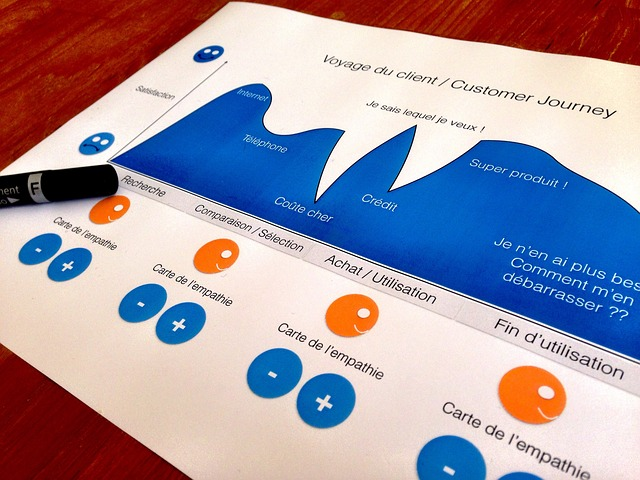We’ll increase conversions by
20-100+%
on your website.
Get a FREE Audit today
See how we can help your business increase conversion rates
Maximizing Ecommerce Success With Effective Customer Journey Mapping Strategies

In the world of e-commerce, understanding your customers’ journey is key to success. Customers have high expectations when shopping online, and meeting those expectations means providing an exceptional experience at every touchpoint.
That’s where customer journey mapping comes in – it allows you to track each step of your customer’s journey and find opportunities for improvement. By gaining a deeper understanding of their pain points, preferences, and behaviors, you can create a more personalized and satisfying online shopping experience.
In this blog post, we’ll explore the benefits of customer journey mapping in e-commerce and share tips on how to create effective strategies that will maximize your business’s success. So buckle up, put yourself in your customers’ shoes, and let’s dive into the world of customer journey mapping!
Understanding Customer Journey Mapping In E-commerce

Customer journey mapping is the process of visualizing every step in a customer’s interaction with an e-commerce business, from their initial awareness to their final purchase, and it helps businesses identify gaps, pain points, and opportunities for improvement in customer experience.
What is Customer Journey Mapping
Customer journey mapping is a process of visualizing the customer experience with a brand from their perspective. It involves identifying all the touchpoints where customers interact with the brand, both online and offline. By doing so, e-commerce businesses can gain deeper insight into how their customers feel and identify opportunities to improve their experience.
One of the major benefits of customer journey mapping in e-commerce is that it helps increase conversions by improving user experience. Mapping out each stage of the customer’s buying process allows businesses to identify potential barriers that may deter them from making a purchase. This allows businesses to find solutions and make improvements where necessary, leading to increased sales and revenue for the business.
Identifying Multiple Touchpoints And Channels
Multiple customer touchpoints and channels refer to all the places where a customer can come into contact with a brand, including social media, email marketing, online chat support, and more. By identifying these touchpoints and improving them, businesses can enhance their e-commerce experience for customers.
For instance, if customers complain about long wait times on the phone or difficulties finding items on your website FAQ page during research phases of their buying process while interacting with your business’s digital profiles or pages such as Facebook ad campaigns make sure you address these issues directly in the customer journey map. Then take proactive steps to improve those areas so that they don’t cause frustration for future buyers. Mapping out customer interactions across multiple touchpoints also provides insights into how best to engage and relate to potential customers based on where they spend time in each channel.
Identifying multiple touchpoints provides an opportunity to provide additional value at every stage of a customer’s shoes and journey by creating content tailored specifically towards different channels from both a sales perspective (conversion tactics) as well as from an educational standpoint (helpful information). With targeted messages that are location-specific which easily helps the buyer find relevant information they require – this increases retention rates and leads for any e-commerce business.
Using Data To Identify Customer Needs And Pain Points
Effective customer journey mapping strategies rely heavily on data to identify customer needs and pain points. By analyzing data on customer behavior, firms can gain deeper insights into their typical customers and their journeys. This allows businesses to accurately predict how customers will interact with them in the future and find solutions to improve the experience.
Through surveys, reviews, and other forms of feedback collection, companies can also better understand existing customer pain points. This information can be used to create a more personalized communication approach that addresses specific concerns or issues, improving overall satisfaction and retention rates.
Effective Customer Journey Mapping Strategies

To create an effective customer journey map, businesses must focus on developing buyer personas, improving website design and user experience, personalizing communication and marketing, implementing effective customer service strategies, and developing a roadmap for improvement.
Creating Buyer Personas
One of the key elements of effective customer journey mapping strategies is creating buyer personas. These personas are fictional representations of your ideal customers and help you understand how the customer interacts, their needs, preferences, behaviors, and pain points. By analyzing data and conducting market research, you can identify commonalities among existing customers and use this information to create multiple personas that accurately reflect the different types of customers who interact with your brand.
Developing buyer personas allows you to see things from the customer’s perspective and gain a deeper understanding of their buying process. Once these personas have been created, they can be used as a guide for all teams within the organization to align with customer expectations. The customer service team and teams can use them in providing proactive customer service while sales teams would find them invaluable in identifying touchpoints where they can pitch solutions that truly resonate with potential customers.
Developing A Roadmap For Improvement
Developing a roadmap for improvement is crucial in customer journey mapping. It involves identifying gaps and pain points in the existing customer journey and creating a plan to enhance it. With proper planning, businesses can streamline their processes, improve communication with customers, and optimize the user experience on their websites or mobile applications.
The roadmap should be structured based on the insights gained from customer feedback, market research, sales data analysis, and other relevant sources. By prioritizing key areas of improvement such as website design, customer service strategy, product offerings, or marketing communication; businesses can create actionable plans that are tailored to meet the unique needs of their customers. This results in an enhanced overall shopping experience for potential and returning customers alike while increasing retention rates over time.
Improving Website Design And User Experience
Improving website design and user experience is essential to ensuring a seamless customer journey. Your customers will have a better experience when your website is visually appealing, easy to navigate, and loads quickly. When designing your website with the customer in mind, consider their perspective and try to anticipate what they might be looking for.
In addition to aesthetics, it’s important to make sure that every aspect of your site is easily accessible for customers from all devices. A responsive design ensures that potential buyers can visit at any time using their preferred device without any issues. According to a survey conducted by Google in 2020, 53% of mobile users abandon sites that take longer than three seconds to load. By improving website design and user experience, you not only keep visitors on your site but also reduce bounce rates while increasing engagement with new or existing customers.
Personalizing Communication And Marketing
Personalizing communication and marketing are one of the key elements of an effective customer journey mapping strategy. By using data collected from the customer journey map, businesses can create targeted messages that address specific consumer needs and interests. This not only demonstrates a brand’s commitment to its customers but also helps build stronger relationships and trust.
One way to personalize communication is through email marketing campaigns. For example, by analyzing which products or services a customer has previously purchased, companies can send personalized emails with product recommendations or promotional offers based on their preferences. This shows customers that brands are paying attention to their needs and wants, making them more likely to continue doing business in the future.
Implementing Effective Customer Service Strategies
Implementing effective customer service strategies is crucial when it comes to e-commerce success. By providing exceptional customer service, businesses can build stronger relationships with their customers and keep them coming back for more. One way to achieve this is by personalizing communication and marketing. By understanding a customer’s needs and preferences, businesses can tailor their messages to create a personalized experience.
Another important aspect of effective customer service strategies in e-commerce is implementing proactive customer service. This means anticipating a customer’s needs before they even ask for help. Businesses should ensure that all relevant teams are involved in delivering an outstanding experience throughout the entire customer journey mapping an important map, from website design to post-purchase support. Continuously updating and improving your journey map using data and analytics can help identify areas needing improvement or those that reflect common customer pain points as well as enhance the overall user experience with each interaction along the way ultimately leading towards higher retention rates in new customers while building brand loyalty among existing ones.
Examples Of Successful Customer Journeys Mapping In E-commerce
Amazon, Zappos, and Sephora are examples of companies that have successfully implemented customer journey mapping strategies to improve the overall customer experience and increase sales.
Amazon
Amazon is one of the most successful e-commerce companies in the world, and its customer journey-mapping strategies have contributed to its success. They use data extensively to understand their customers’ needs and behaviors throughout their shopping and create a customer journey here. One way Amazon has optimized its customer journey map is by providing personalized recommendations based on previous purchases and browsing history.
Another important aspect of Amazon’s customer journey mapping strategy is the emphasis on product reviews. They encourage customers to leave feedback and reviews, which are then used to improve products, services, and overall customer experience. This approach helps build trust with potential customers who may be considering purchasing from Amazon for the first time but rely on social proof before making a decision.
Zappos
Zappos is a trendy American online retailer that specializes in footwear and clothing. The company has set itself apart by prioritizing customer service, including a 365-day return policy, to ensure customers have the best experience possible.
Zappos is known for its effective implementation of customer journey mapping tools and strategies to enhance the overall buying process. By identifying potential touchpoints and pain points in their customers’ journeys, Zappos gained insights into what their customers truly want and need. This strategy has helped them retain more customers while also boosting e-commerce success rates.
Sephora
Sephora has become one of the most prominent e-commerce companies known for its exceptional customer journey mapping. The company specializes in the beauty industry and has effectively implemented an omnichannel strategy to enhance the customer experience across their brand. Sephora’s multichannel integration allows customers to have a seamless purchase process, from browsing products on their website to trying them out in-store.
Sephora’s tech-savvy approach to building brand loyalty has propelled its success in the industry. With an emphasis on gathering marketing data, Sephora ensures that technology is a primary driver behind delivering exceptional experiences tailored for each customer’s needs. The brand also offers personalized communications and promotions based on each user’s individual preferences, providing a sense of exclusivity that keeps customers engaged with the brand even outside of transactions.
The Role Of Data In Customer Journey Mapping

Analyzing data is essential in identifying customer behaviors, collecting feedback and reviews, and implementing data-driven decisions to improve the effectiveness of customer journey mapping strategies.
Analyzing Data To Identify Customer Behaviors
Analyzing data is a crucial step in creating an effective customer journey map for your e-commerce business. By collecting and analyzing data about customer behaviors, you can gain important insights into their needs and pain points at each stage of the buying process. This information can then be used to create a more personalized and engaging experience for your customers.
One way to gather this valuable data is through customer feedback and reviews. Monitoring what customers are saying about your brand on social media or review sites can help you identify common pain points that need to be addressed in your customer journey map. Another approach is to use machine learning or Python to analyze large amounts of customer data across multiple touchpoints in the basic customer journey map, allowing you to accurately predict behavior patterns and anticipate future needs.
Collecting Feedback And Reviews
Collecting customer feedback and reviews is a crucial aspect of creating an effective customer journey map. By gathering insights directly from customers, eCommerce businesses can gain deeper insights into their behavior and preferences. This information helps businesses identify the touchpoints that matter most to customers and pinpoint any pain points they encounter during their journey.
Customer feedback also serves as a valuable tool for measuring the success of your customer journey map. With metrics such as the Net Promoter Score (NPS) and Customer Satisfaction Score (CSAT), companies can monitor how well they are meeting customer expectations throughout the entire buying process. By using data-driven decisions based on customer feedback, businesses can improve their overall retention rates and build long-term relationships with their customers.
Implementing Data-driven Decisions
Implementing data-driven decisions is an essential aspect of effective customer journey mapping strategies. Analyzing customer data can help businesses identify patterns and behaviors that might have gone unnoticed before. By understanding the customers’ needs and pain points, companies can take steps to improve their website design, user experience, communication, marketing, and customer service strategies.
Collecting feedback and reviews are excellent ways to gather relevant data about your customers’ experiences with your brand. It helps businesses understand what’s working well for them and what could be improved. Implementing data-driven decisions based on this information will allow e-commerce business owners to make informed decisions when it comes to improving their overall customer journey maps in the future.
Tips For Implementing An Effective Customer Journey Map In Your E-commerce Business

To implement an effective customer journey map in your e-commerce business, conduct thorough research, involve all relevant teams, continuously update and improve the map using data and analytics to support your mapping, focus on the customer experience, and ensure that you involve customers directly in multiple journey maps order to gain deeper insights into their needs and expectations.
Conducting Thorough Research
In order to create an effective customer journey map for your e-commerce business, conducting thorough research is crucial. This includes gathering data on existing customer interactions and touchpoints across various channels such as social media, email marketing, and your website. By doing so, you can gain a deeper understanding of the average customer and experience and identify any potential pain points.
Furthermore, conducting market research can help you understand the typical behaviors of your target audience and their preferences when it comes to purchasing products or services online. This information can then be used to create buyer personas that accurately reflect your customers’ needs and expectations. Overall, by investing time in thorough research before creating a customer journey map, you can ensure that the final, product or service made is tailored to meet the specific needs of your audience and improve their overall experience with your brand.
Involving All Relevant Teams
Involving all relevant teams is a critical component of an effective customer journey mapping strategy. This includes not just the marketing and sales teams, but also those responsible for product development, customer service, and operations. By involving everyone in entire organization who interacts with customers in some way, a business can gain a comprehensive understanding of the entire customer experience from start to finish.
When all teams work together to create a shared understanding of the customer’s journey, it becomes easier to identify pain points and areas for improvement. For example, the product development team may discover that certain features are causing frustration for customers during their interactions with the brand. By collaborating with other departments such as marketing and sales, they can implement changes that improve the overall customer’s experience and increase profitability.
Continuously Updating And Improving The Map
Once you have developed your customer journey map, it is important to continuously update and improve it. This helps to ensure that the map accurately reflects changes in customer behavior and experiences. Regularly reviewing and updating the customer journey map templates allows you to identify gaps or pain points that customers may be experiencing at different stages of their eCommerce journey.
To keep up with changing customer needs, feedback must be collected regularly through surveys and reviews. Analytics from website traffic can also provide valuable insights on how customers interact with your brand. By incorporating data-driven decisions into your updates, you can make informed improvements to the map that enhance the overall customer experience.
Using Data And Analytics To Support Your Mapping
Data and analytics play a critical role in creating an effective customer journey map for your e-commerce business. By analyzing the data from past interactions with customers, you can get insights into their behaviors, preferences, and pain points. This information will enable you to make data-driven decisions that improve the overall customer experience.
One way to use data to support your customer journey mapping examples is by collecting feedback from customers at each touchpoint of their journey. Based on this feedback, you can identify the areas that require improvement and take corrective action proactively. Additionally, keeping track of metrics such as conversion rates or customer retention rate can help measure the success of your customer journey map over time. Data and analytics provide valuable insight into what’s working well in your customer’s journey and where improvements need to be made ensuring a more satisfying experience for potential buyers down the line.
Focusing On The Customer Experience
Focusing on the customer experience is an essential aspect of customer journey mapping in e-commerce. It involves understanding the needs, behaviors and preferences of your customers. By doing so, businesses can create tailored experiences that cater to their customers’ specific requirements, leading to increased engagement and loyalty.
One way of improving the customer experience is by personalizing communication and marketing efforts based on a buyer persona developed during research. This allows businesses to tailor their offering based on customer feedback and interactions throughout multiple touchpoints. Effective communication enhances brand perception, helping gain insights that can be used for continuous improvement of products or services offered. Therefore focusing more intently on customer persona and creating personalized messaging plays a crucial role in enhancing ecommerce success through effective customer journey mapping strategies.
Measuring The Success Of Customer Journey Maps

]In order to measure the success of customer journey maps, it is important to set key performance indicators (KPIs) and metrics, monitor customer satisfaction and track conversion rates.
Setting KPIs And Metrics
Setting Key Performance Indicators (KPIs) and metrics is a vital component when measuring the success of customer journey maps in maximizing ecommerce success. KPIs help track if every step taken by the company aligns with their objectives, while metrics quantify progress towards achieving those goals. By setting up KPIs and metrics such as conversion rates, customer retention rates, and satisfaction levels, businesses can ensure that they are on track to meet their desired outcomes.
Ecommerce KPIs provide a comprehensive view of the customer experience and buyer journey. These include website traffic sources from paid or organic searches, add-to-cart rates, cart abandonment rate during checkout process, social media engagement rate per post, revenue per visit or average order value among others. Measuring these metrics helps brands identify pain points along the way where customers may be dropping off or not engaging enough with their products or services. Addressing issues found in specific areas of the customer’s journey can improve overall sales volume and increase profits for businesses online.
Monitoring Customer Satisfaction
Monitoring customer satisfaction is an important step in evaluating the success of your ecommerce business. By measuring metrics such as customer retention rate and tracking conversion rates, you can gain deeper insights into how customers interact with your brand over time. Additionally, collecting feedback and reviews from customers can give you a more accurate understanding of their experiences and identify any pain points that need addressing.
A successful customer journey map should accurately reflect the pulse of your consumer base by identifying touchpoints where customers directly or indirectly interact with your brand. Customer service teams play an essential role in this by providing proactive assistance to help customers feel heard and valued throughout their entire journey. Combined with data analysis, monitoring customer satisfaction helps businesses create tailored solutions for common issues faced by their typical customers while personalizing communication through targeted marketing initiatives based on specific buyer personas.
Tracking Conversion Rates
Tracking conversion rates is an essential metric for measuring ecommerce success. Conversion rate refers to the percentage of website visitors who complete a desired action, such as making a purchase or filling out a form. By tracking conversion rates, businesses can identify areas where they need to improve their customer journey map and optimize their website design and user experience.
An effective customer journey map can significantly increase conversions and ultimately impact revenue. By pinpointing each stage of the buyer’s journey and analyzing data, businesses can gain insight into what motivates customers to make purchases on their website. This information allows companies to create personalized marketing messages that resonates with customers at each touchpoint in their buying process, leading to higher conversion rates and increased sales. You can also read through some of our informative case studies to see how it’s done.
Conclusion
In today’s competitive ecommerce landscape, customer journey mapping is crucial for businesses looking to maximize their online success. By creating a shared understanding of the entire customer journey, you can identify critical touchpoints and pain points to improve the overall experience.
With effective customer journey mapping strategies in place, you can personalize communication and marketing efforts, survey customers, improve website design and user experience, and implement proactive customer service that accurately reflects your customers’ needs. So don’t wait any longer; get started on creating an effective customer journey map for your e-commerce business today!








